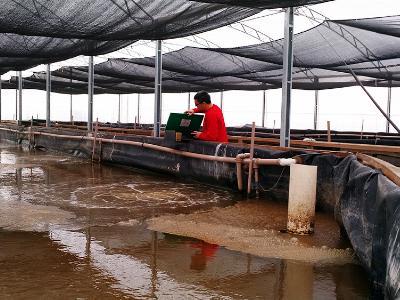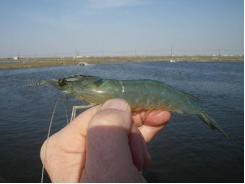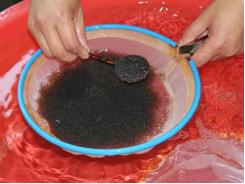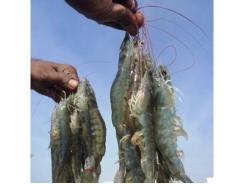Biofloc consumption by Pacific white shrimp postlarvae

Using the stable isotope technique to determine relevance of food sources
Management of nursery system.
In the early stages of marine shrimp culture, a diet including live food can be more efficient as a food source because these food items remain viable for a longer time in the water column and have high digestibility. However, live food is expensive to produce and maintain, and depends on highly-trained workers for their production.
The Biofloc Culture Systems – BFT (Biofloc Technology) can be a good source of live food in the grow-out phase of marine shrimp production. This technology is based on the addition of an organic carbon source that is used by bacteria to convert the excess nitrogen in the microbial biomass in the production tanks, and thus it can reduce water exchanges. In the early stages of larval shrimp rearing (from PL-1 phase until PL-30), shrimp production is generally performed in clear water systems with the addition of food items like phytoplankton, zooplankton (Artemia sp.) and commercial feeds, and using high water exchange rates. An alternative feed can be the incorporation of BFT systems for these early life stages. However, information is needed on the consumption and assimilation of bioflocs by young, developing postlarvae of shrimp.

Different food sources (A: Artemia; B: bioflocs; C: commercial aquafeed; D: ciliates; E, F: microalgae) and shrimp postlarvae (G, H) used in the trial.

Production of live food for the study. A&B: Artemia culture; C&D: microalgae cultures; E: Harvesting decapsulated Artemia nauplii.
The stable isotope technique has been used as a complement to conventional techniques used in diet studies, because it can show the proportion of each prey/feed assimilated into the predator animal’s diet. The principle of this technique is that stable isotopes of different chemical elements in the animal tissue reflect the ratio present in the food consumed, and this is registered as a signature in the new formed tissues of the consuming animal.
Study setup
The experiment lasted for 30 days, starting with one-day-old (PL1) shrimp postlarvae, and used two different strategies to control ammonia when concentrations reached 0.5 mg/L. The first strategy was water exchange at a rate of approximately 70 percent of the total volume (the control treatment), and the second strategy included organic fertilization with dextrose (the BFT treatment) with no water exchange.
In both treatments, shrimp were fed with three different commercial feeds (CF), according to the animal stage development; shrimp were fed three times per day with commercial feeds, and once with frozen Artemia sp. nauplii. The microalgae Chaetoceros muelleri was inoculated into the experimental tanks in the first experimental day at a concentration of 5 x 104 cells/mL.

Weighing samples for stable isotopes analysis.
For water quality monitoring, dissolved oxygen, temperature and pH were measured daily. Ammonia (N- (NH3 + NH4+)) was analyzed every two days. Nitrite (N-NO2–) and phosphate (P-PO43-) were measured weekly. Alkalinity (mg/L CaCO3) and nitrate (N-NO3–) were determined in the initial and final samples. The growth performance of test animals was evaluated by size, weight and survival.
Samples of different food sources, bioflocs and shrimp postlarvae were collected on the 10th, 20th and 30th days of the experiment to determine the carbon and nitrogen isotopic values. All of the samples were ground, weighed and placed into tin capsules. The analyses of carbon (13C / 12C) and nitrogen (15N / 14N) isotopic ratios were performed at the UC Davis Stable Isotope Facility, CA, USA. The Bayesian model of isotopic mixtures (package SIAR) was used to determine the relative contributions of food sources to the growth of shrimp in the different culture periods.
Results and perspectives
During the trial, no differences were determined in the performance parameters analyzed for the shrimp postlarvae (Table 1), or in the water quality parameters (Table 2), all of which remained within recommended values for L. vannamei. The commercial feeds tended to increase their contribution to the animals in both treatments (Figures 1 and 2). However, we observed that the biofloc contribution was around 50 percent (Figure 2). In the BFT treatment, the bioflocs appeared to have an important role in the performance of L. vannamei postlarvae. The microalgae presented a similar contribution when compared to the bioflocs in the BFT treatment, and in both treatments, microalgae were assimilated more than the Artemia sp. nauplii.

Fig. 1 (left): Average values (proportion x 100 percent) of the contribution of different food sources provided to Pacific white shrimp postlarvae during production in the CT (Control Treatment) on the 30th day. Fig. 2 (right): Average values (proportion x 100 percent) of the contribution of different food sources provided to Pacific white shrimp postlarvae during production in the BT (Biofloc Treatment) on the 30th day.
Suita, Table 1
| Treatments | CT | BT |
| Survival (%) | 93.2 ± 7.11 | 91.2 ± 8.53 |
| Initial biomass (g) | 0.065 ± 0.002 | 0.065 ± 0.002 |
| Final biomass (g) | 3.16 ± 0.7 | 3.14 ± 0.44 |
Performance values (mean ± SD) of Pacific white shrimp postlarvae in the CT and BT.
Suita, Table 2
| Treatments | CT | BT |
| Temperature (degrees C) | 27.8 ± 1.14 | 28.13 ± 1.33 |
| Oxygen (mg L-1) | 5.72 ± 0.4 | 5.73 ± 0.49 |
| Salinity | 30.16 ± 0.98a | 31.33 ± 0.52b |
| pH | 8.05 ± 0.24 | 8.04 ± 0.23 |
| Alkalinity (mg L-1 as CaCO3) | 248.75 ± 2.5a | 112.5 ± 14.43b |
| Phosphate (mg L-1) | 0.99 ± 0.6 | 1.93 ± 1.21 |
| Ammonia (mg L-1) | 0.65 ± 0.15 | 0.65 ± 0.1 |
| Nitrite (mg L-1) | 0.7 ± 0.15a | 1.34 ± 0.3b |
| Nitrate (mg L-1) | 1.32 ± 1.17 | 1.9 ± 2 |
Values (mean ± SD) for physico-chemical variables of water quality monitored during the test of Pacific white shrimp postlarvae in the CT and BT.
It was observed that Artemia sp. had a smaller contribution than other food sources in the growth of postlarvae (Figures 1 and 2). Despite being financially advantageous to reduce its use, it is unknown what proportions or what direct effect any reduction in the use of Artemia sp. could cause in shrimp postlarvae, because this food source provides nutrients that are necessary for the proper development of early life stages of penaeid shrimp.
During the pre-nursery phase, the influence of inert feed (or commercial feed) on the growth of the L. vannamei postlarvae increased over time, but young animals in the presence of bioflocs can obtain nutritional benefits, increasing their growth. In addition to this nutritional increase, fertilizations with carbon sources can reduce the amount of water used in the hatchery/pre-nursery phase.
Sabrina M. Suita, Alessandro P. Cardozo, Paulo Cesar Abreu, Wilson Wasielesky Jr., Ph.D.
Marine Station of Aquaculture, Institute of Oceanography, Federal University of Rio Grande, C.P.474-Rio Grande (RS)-CEP 96201-900- Brazil
Related news
Tools

Phối trộn thức ăn chăn nuôi

Pha dung dịch thủy canh

Định mức cho tôm ăn

Phối trộn phân bón NPK

Xác định tỷ lệ tôm sống

Chuyển đổi đơn vị phân bón

Xác định công suất sục khí

Chuyển đổi đơn vị tôm

Tính diện tích nhà kính

Tính thể tích ao




 Critical decisions for shrimp harvesting and packing, Part…
Critical decisions for shrimp harvesting and packing, Part…  Saudi Arabia developing effective farmed shrimp biosecurity strategy
Saudi Arabia developing effective farmed shrimp biosecurity strategy